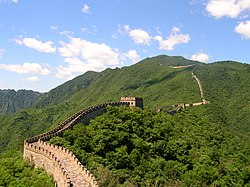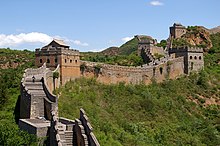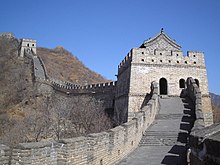Waiting day end and come in worlds china wall
Great Wall of China
The Great Wall of China is a series of stone and earthen fortifications in northern China, built originally to protect the northern borders of the Chinese Empire against intrusions by various nomadic groups. Several walls have been built since the 5th century BC that are referred to collectively as the Great Wall, which has been rebuilt and maintained from the 5th century BC through the 16th century. One of the most famous is the wall built between 220–206 BC by the first Emperor of China, Qin Shi Huang. Little of that wall remains; the majority of the existing wall was built during the Ming Dynasty.
The Great Wall stretches from Shanhaiguan in the east, to Lop Nur in the west, along an arc that roughly delineates the southern edge of Inner Mongolia. The most comprehensive archaeological survey, using advanced technologies, has recently concluded that the entire Great Wall, with all of its branches, stretches for 8,851.8 km (5,500.3 mi). This is made up of 6,259.6 km (3,889.5 mi) sections of actual wall, 359.7 km (223.5 mi) of trenches and 2,232.5 km (1,387.2 mi) of natural defensive barriers such as hills and rivers.
| The Great Wall* | |
|---|---|
| UNESCO World Heritage Site | |
 | |
| State Party | |
| Type | Cultural |
| Criteria | i, ii, iii, iv, vi |
| Reference | 438 |
| Region** | Asia-Pacific |
History
The Chinese were already familiar with the techniques of wall-building by the time of the Spring and Autumn Period, which began around the 8th century BC.[5][6] During the Warring States Period from the 5th century BC to 221 BC, the states of Qin, Wei, Zhao, Qi, Yan andZhongshan[7][8] all constructed extensive fortifications to defend their own borders. Built to withstand the attack of small arms such as swords and spears, these walls were made mostly by stamping earth and gravel between board frames.
Qin Shi Huang conquered all opposing states and unified China in 221 BC, establishing the Qin Dynasty. Intending to impose centralized rule and prevent the resurgence of feudal lords, he ordered the destruction of the wall sections that divided his empire along the former state borders. To protect the empire against intrusions by the Xiongnu people from the north, he ordered the building of a new wall to connect the remaining fortifications along the empire's new northern frontier. Transporting the large quantity of materials required for construction was difficult, so builders always tried to use local resources. Stones from the mountains were used over mountain ranges, while rammed earth was used for construction in the plains. There are no surviving historical records indicating the exact length and course of the Qin Dynasty walls. Most of the ancient walls have eroded away over the centuries, and very few sections remain today. Later, theHan, Sui, Northern and Jin dynasties all repaired, rebuilt, or expanded sections of the Great Wall at great cost to defend themselves against northern invaders. It is estimated that over 1 million workers died building the wall.[9]
The Great Wall concept was revived again during the Ming Dynasty, following the Ming army's defeat by the Oirats in the Battle of Tumu in 1449. The Ming had failed to gain a clear upper-hand over the Manchurian and Mongolian tribes after successive battles, and the long-drawn conflict was taking a toll on the empire. The Ming adopted a new strategy to keep the nomadic tribes out by constructing walls along the northern border of China. Acknowledging the Mongol control established in the Ordos Desert, the wall followed the desert's southern edge instead of incorporating the bend of the Huang He.
Unlike the earlier Qin fortifications, the Ming construction was stronger and more elaborate due to the use of bricks and stone instead of rammed earth. As Mongol raids continued periodically over the years, the Ming devoted considerable resources to repair and reinforce the walls. Sections near the Ming capital of Beijing were especially strong.[citation needed]
During the 1440s–1460s, the Ming also built a so-called "Liaodong Wall". Similar in function to the Great Wall (whose extension, in a sense, it was), but more basic in construction, the Liaodong Wall enclosed the agricultural heartland of the Liaodong province, protecting it against potential incursions by Jurched-Mongol Oriyanghan from the northwest and the Jianzhou Jurchens from the north. While stones and tiles were used in some parts of the Liaodong Wall, most of it was in fact simply an earth dike with moats on both sides.[10]
Towards the end of the Ming Dynasty, the Great Wall helped defend the empire against theManchu invasions that began around 1600. Under the military command of Yuan Chonghuan, the Ming army held off the Manchus at the heavily fortifiedShanhaiguan pass, preventing the Manchus from entering the Chinese heartland. The Manchus were finally able to cross the Great Wall in 1644, when the gates at Shanhaiguan were opened by Wu Sangui, a Ming border general who disliked the activities of rulers of the Shun Dynasty. The Manchus quickly seized Beijing, and defeated the newly founded Shun Dynasty and remaining Ming resistance, to establish the Qing Dynasty.
In 2009, an additional 290 km (180 mi) of previously undetected portions of the wall, built during the Ming Dynasty, were discovered. The newly discovered sections range from the Hushan mountains in the northern Liaoning province, toJiayuguan in western Gansu province. The sections had been submerged over time by sandstorms which moved across the arid region.[11]
Under Qing rule, China's borders extended beyond the walls and Mongolia was annexed into the empire, so construction and repairs on the Great Wall were discontinued.
Notable areas
Some of the following sections are in Beijing municipality, which were renovated and which are regularly visited by modern tourists today.
- "North Pass" of Juyongguan pass, known as the Badaling. When used by the Chinese to protect their land, this section of the wall has had many guards to defend China’s capital Beijing. Made of stone and bricks from the hills, this portion of the Great Wall is 7.8 meters (25.6 ft) high and 5 meters (16.4 ft) wide.
- "West Pass" of Jiayuguan (pass). This fort is near the western edges of the Great Wall.
- "Pass" of Shanhaiguan. This fort is near the eastern edges of the Great Wall.
- One of the most striking sections of the Ming Great Wall is where it climbs extremely steep slopes. It runs 11 kilometers (7 mi) long, ranges from 5 to 8 meters (16–26 ft) in height, and 6 meters (19.7 ft) across the bottom, narrowing up to 5 meters (16.4 ft) across the top. Wangjinglou is one of Jinshanling's 67 watchtowers, 980 meters (3,215 ft) above sea level.
- South East of Jinshanling, is the Mutianyu Great Wall which winds along lofty, cragged mountains from the southeast to the northwest for approximately 2.25 kilometers (about 1.3 miles). It is connected with Juyongguan Pass to the west and Gubeikou to the east.
- 25 km (16 mi) west of the Liao Tian Ling stands apart of Great Wall which is only 2~3 stories high. According to the records of Lin Tian, the wall was not only extremely short compared to others, but it appears to be silver. Archeologists explain that the wall appears to be silver because the stone they used were from Shan Xi, where many mines are found. The stone contains extremely high levels of metal in it causing it to appear silver. However, due to years of decay of the Great Wall, it is hard to see the silver part of the wall today.
Another notable section lies near the eastern extremity of the wall, where the first pass of the Great Wall was built on the Shanhaiguan (known as the “Number One Pass Under Heaven”). 3km north of Shanhaiguan is Jiaoshan Great Wall, the site of the first mountain of the Great Wall.[12] 15km northeast from Shanhaiguan, is the Jiumenkou, which is the only portion of the wall that was built as a bridge.
Characteristics
Before the use of bricks, the Great Wall was mainly built from rammed earth, stones, and wood. During the Ming Dynasty, however, bricks were heavily used in many areas of the wall, as were materials such as tiles, lime, and stone. The size and weight of the bricks made them easier to work with than earth and stone, so construction quickened. Additionally, bricks could bear more weight and endure better than rammed earth. Stone can hold under its own weight better than brick, but is more difficult to use. Consequently, stones cut in rectangular shapes were used for the foundation, inner and outer brims, and gateways of the wall. Battlements line the uppermost portion of the vast majority of the wall, with defensive gaps a little over 30 cm (12 in) tall, and about 23 cm (9.1 in) wide.
Condition
While some portions north of Beijing and near tourist centers have been preserved and even extensively renovated, in many locations the Wall is in disrepair. Those parts might serve as a village playground or a source of stones to rebuild houses and roads.[13] Sections of the Wall are also prone to graffiti and vandalism. Parts have been destroyed because the Wall is in the way of construction.[14]
More than 60 km (37 mi) of the wall in Gansu province may disappear in the next 20 years, due to erosion from sandstorms. In places, the height of the wall has been reduced from more than five meters (16.4 ft) to less than two meters. The square lookout towers that characterize the most famous images of the wall have disappeared completely. Many western sections of the wall areconstructed from mud, rather than brick and stone, and thus are more susceptible to erosion.[15]
Watchtowers and barracks
Communication between the army units along the length of the Great Wall, including the ability to call reinforcements and warn garrisons of enemy movements, was of high importance. Signal towers were built upon hill tops or other high points along the wall for their visibility.
Visibility from space
Visibility from the moon
Popular beliefs ranging from Ripley's Believe It or Not!'s cartoons from 1930s, which claimed that the Great Wall is "the mightiest work of man, the only one that would be visible to the human eye from the moon," to Richard Halliburton's 1938 book Second Book of Marvels which makes a similar claim, have persisted, assuming urban legend status, and sometimes even appearing in school textbooks. Arthur Waldron, author of The Great Wall of China: From History to Myth, has speculated that the belief might go back to the fascination with the "canals"once believed to exist on Mars.
One of the earliest known references to this myth appears in a letter written in 1754 by the English antiquary William Stukeley. Stukeley wrote that, "This mighty wall of four score miles in length (Hadrian's Wall) is only exceeded by the Chinese Wall, which makes a considerable figure upon the terrestrial globe, and may be discerned at the moon."[16]
The Great Wall is a maximum 9.1 m (30 ft) wide, and is about the same color as the soil surrounding it. Based on the optics of resolving power (distance versus the width of the iris: a few millimeters for the human eye, meters for large telescopes) only an object of reasonable contrast to its surroundings which is 70 mi (110 km) or more in diameter (1 arc-minute) would be visible to the unaided eye from the moon, whose average distance from Earth is 384,393 km (238,851 mi). The apparent width of the Great Wall from the moon is the same as that of a human hair viewed from 2 miles away. To see the wall from the moon would require spatial resolution 17,000 times better than normal (20/20) vision.[17] Unsurprisingly, no lunar astronaut has ever claimed to have seen the Great Wall from the moon.
Visibility from low earth orbit
A more controversial question is whether the Wall is visible from low earth orbit (an altitude of as little as 100 miles (160 km)). NASA claims that it is barely visible, and only under nearly perfect conditions; it is no more conspicuous than many other man-made objects.[18] Other authors have argued that due to limitations of the optics of the eye and the spacing of photoreceptors on the retina, it is impossible to see the wall with the naked eye, even from low orbit, and would require visual acuity of 20/3 (7.7 times better than normal).[17]
Anecdotal reports
Astronaut William Pogue thought he had seen it from Skylab but discovered he was actually looking at the Grand Canal of China near Beijing. He spotted the Great Wall with binoculars, but said that "it wasn't visible to the unaided eye." U.S. Senator Jake Garn claimed to be able to see the Great Wall with the naked eye from a space shuttle orbit in the early 1980s, but his claim has been disputed by several U.S. astronauts. Veteran U.S. astronaut Gene Cernan has stated: "At Earth orbit of 100 miles (160 km) to 200 miles (320 km) high, the Great Wall of China is, indeed, visible to the naked eye." Ed Lu, Expedition 7 Science Officer aboard the International Space Station, adds that, "it's less visible than a lot of other objects. And you have to know where to look."
In 2001, Neil Armstrong stated about the view from Apollo 11: "I do not believe that, at least with my eyes, there would be any man-made object that I could see. I have not yet found somebody who has told me they've seen the Wall of China from Earth orbit. ...I've asked various people, particularly Shuttle guys, that have been many orbits around China in the daytime, and the ones I've talked to didn't see it."[19]
In October 2003, Chinese astronaut Yang Liwei stated that he had not been able to see the Great Wall of China. In response, the European Space Agency (ESA) issued a press release reporting that from an orbit between 160 and 320 km, the Great Wall is visible to the naked eye. In an attempt to further clarify things, the ESA published a picture of a part of the “Great Wall” photographed from Space. However, in a press release a week later (no longer available in the ESA’s website), they acknowledged that the "Great Wall" in the picture was actually a river.[17]
Leroy Chiao, a Chinese-American astronaut, took a photograph from the International Space Station that shows the wall. It was so indistinct that the photographer was not certain he had actually captured it. Based on the photograph, the China Daily later reported that the Great Wall can be seen from space with the naked eye, under favorable viewing conditions, if one knows exactly where to look.[20] However, the resolution of a camera can be much higher than the human visual system, and the optics much better, rendering photographic evidence irrelevant to the issue of whether it is visible to the naked eye.[17]
Short Story
短篇小说
中国的长城
作者:中国长城有百年历史,可以追溯到古老的7thcentury为公元前远当中国被划分成几个独立的国家。为了保护外来attcks自己,每个国家决定建立一个高风墙,将在全国范围内为几公里的本身。
作为中国第一个皇帝秦始皇开始统治中国,他团结各国公元前221年并下令整修和前独立国家的墙每延长,直到他们都与对方和长城已建立连接。在那些日子里,长城有5000公里长和蔓延,从临洮,在中国西部,这本身就是对辽东在中国的东部。
它的任务是首先formeost保护在以下两千年来,从外面野蛮人中华帝国和北部边界,然后,以确保贸易。在长城已得到改进,拉长整个下列朝代,并因此多次改编,由当时统治帝国的防御的各种需求。
而汉代的长城拉长到10.000公里,在明朝大墙再次缩减六三五〇公里和他们的防御体系,而不是升级的重点。作者认为今天可以看到部分墙体延伸,从山海在东方传递给嘉鱼通甘肃省在西部。
这就是常说的奴隶,囚犯和士兵被迫修建数百万的中国长城,其中许多人死于饥饿和劳累。这就是为什么华尔街被称为“世界上最长的公墓”几个世纪以来闻名。长城有一个受到保护秩序,并自1961年加入了联合国教科文组织的世界遗产名单于1987年。
短篇小说
中国的长城
作者:中国长城有百年历史,可以追溯到古老的7thcentury为公元前远当中国被划分成几个独立的国家。为了保护外来attcks自己,每个国家决定建立一个高风墙,将在全国范围内为几公里的本身。
作为中国第一个皇帝秦始皇开始统治中国,他团结各国公元前221年并下令整修和前独立国家的墙每延长,直到他们都与对方和长城已建立连接。在那些日子里,长城有5000公里长和蔓延,从临洮,在中国西部,这本身就是对辽东在中国的东部。
它的任务是首先formeost保护在以下两千年来,从外面野蛮人中华帝国和北部边界,然后,以确保贸易。在长城已得到改进,拉长整个下列朝代,并因此多次改编,由当时统治帝国的防御的各种需求。
而汉代的长城拉长到10.000公里,在明朝大墙再次缩减六三五〇公里和他们的防御体系,而不是升级的重点。作者认为今天可以看到部分墙体延伸,从山海在东方传递给嘉鱼通甘肃省在西部。
这就是常说的奴隶,囚犯和士兵被迫修建数百万的中国长城,其中许多人死于饥饿和劳累。这就是为什么华尔街被称为“世界上最长的公墓”几个世纪以来闻名。长城有一个受到保护秩序,并自1961年加入了联合国教科文组织的世界遗产名单于1987年。






No comments:
Post a Comment
Jayant Parkash Is Welcome All world to my blog